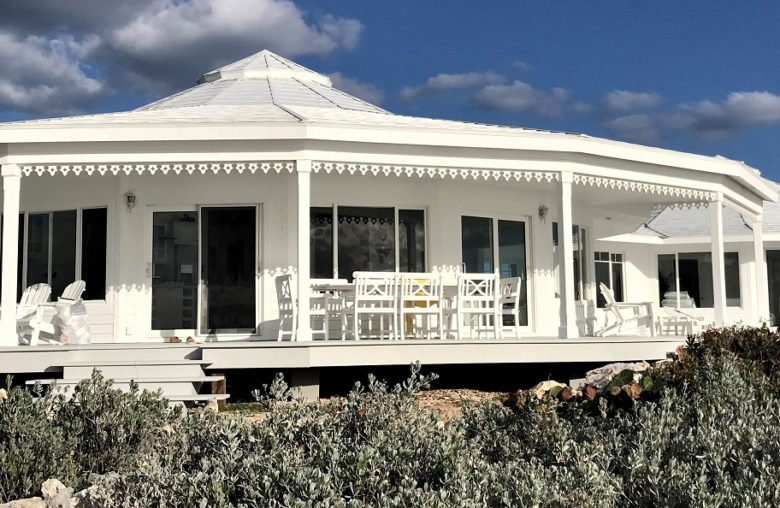The two previous blog posts have pointed out the historical background and the guiding principles of biophilic design, but how might you apply that to your own home or residence?
For this blog, we will approach biophilic design from the perspective of building a new home so that we can highlight the different elements that you can incorporate into your home. However, many elements could also added or incorporated into an existing home. The benefit of thinking about biophilic design as a series of principles and guideline is that any improvements you make can benefit you and there are no hard rules to force you into decisions you don’t want to make—remember biophilic design is an approach to make you happier and healthier in your home.
While approaching biophilic design might seem daunting, breaking it down into the different elements can make it much simpler. We will use one house as an example, to help you understand how to do that with your own project.
Location
If you haven’t chosen your lot yet, think about how it might help your well-being and sense of calm. We are naturally attracted to open vistas and waterfront locations for a reason. Being able to see nature and experience it while being protected is a key aspect to biophilic design.
This home is located on the oceanside of a Caribbean island. It does a fantastic job of bringing the outdoors in with its panoramic views. The windows provide natural light and the occupants of the home can perceive the passing of time from sunrise to sunset.
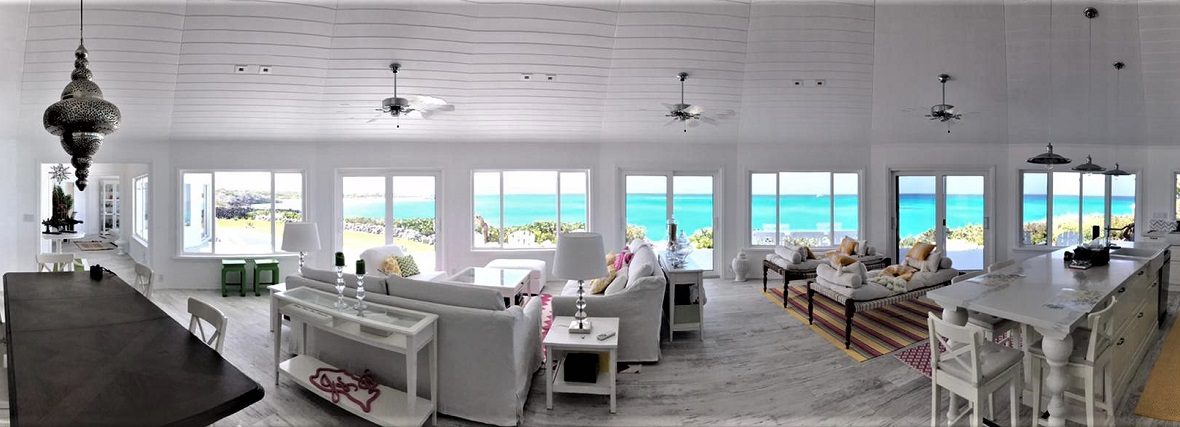
The expansive views also signal opportunities for fun and adventure, like going swimming or scuba diving while providing comfort and protection from the weather by being able to see approaching storms or bad weather before they come too close.
Exterior Approach
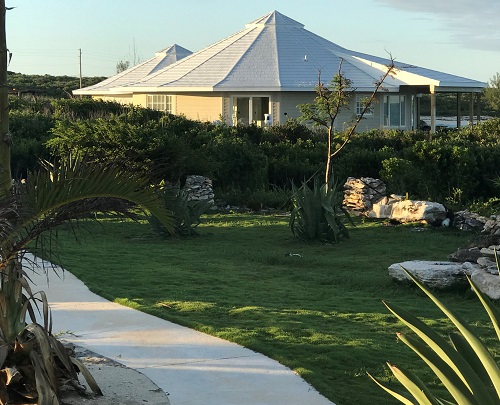 As you think about how your home sits in its environment, look about how to create your home as an extension of nature. Things like creating an organic approach to your home like a winding pathway or natural landscaping including a mix of plants, rocks or geological features creates a sense of well-being and can create a transitional zone from nature to your home.
As you think about how your home sits in its environment, look about how to create your home as an extension of nature. Things like creating an organic approach to your home like a winding pathway or natural landscaping including a mix of plants, rocks or geological features creates a sense of well-being and can create a transitional zone from nature to your home.
Also note how the round home shape evokes nature from the outside. The house here sits organically in the landscape. The unique shape complements the natural structures to create an organic environment rather than the often bulky and unnatural straight lines of many homes. An additional benefit to this shape is its resistance to hurricanes. While this is not traditionally considered a biophilic design principle, we think protection from the extreme wrath of nature is a definite benefit that could be included!
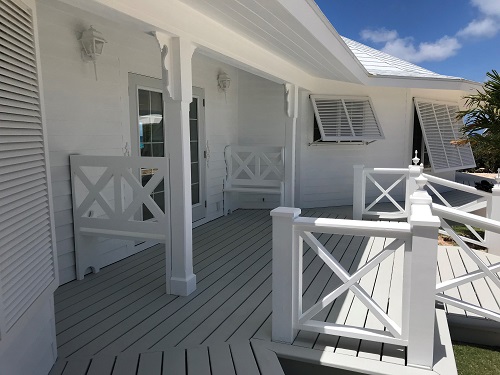
As you come to the entrance, note how this home creates a transitional space outside the home to prepare you to enter the home. Something as simple as outlining the entrance with some outside fence details and an extended landing creates this unique space.
Exterior
The exterior of this home includes a covered deck with lounge chairs and outdoor dining table. Beyond creating additional living area, it also plays a useful role in biophilic design. The porch itself signifies a transition from the inside to the outside, providing a cushioning space for you to m ove between the two areas. Just like the natural richness of an estuary, this space is a very valuable living area. The chairs and table allow you to relax directly interacting and engaging with nature while the structure of the home not only shields your body from the harmful effects of the sun but signals your brain that you are in the protected home environment.
ove between the two areas. Just like the natural richness of an estuary, this space is a very valuable living area. The chairs and table allow you to relax directly interacting and engaging with nature while the structure of the home not only shields your body from the harmful effects of the sun but signals your brain that you are in the protected home environment.
Interior—Overall
Bringing nature into your home can be done in a multitude of ways. We have previously talked about the importance of windows to look out into nature. Colors, materials, textures and patterns are critical ways to help biophilic design create a natural sanctuary for you in your home. Further decorating with plants, furniture and fixtures are great ways to add additional biophilic benefits—and one of the easiest ways if you have an existing home. Just remember that a core principle of biophilic design is to create not just direct and indirect experiences, but spatial ones. So, you should look at how each element creates a larger feeling or environment that mimics natural ones. While a single houseplant is nice, a grouping of natural houseplants creating a natural space within your home is what actually creates a biophilic benefit.
Interior—Colors, materials, textures and patterns
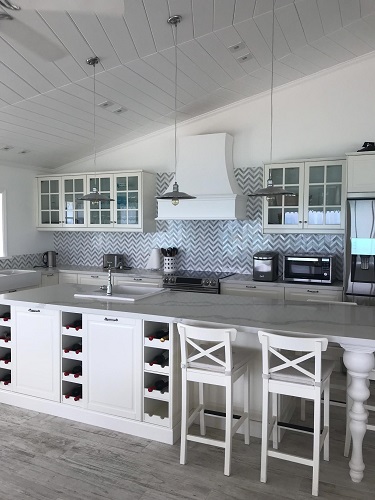 Mimicking nature inside includes using natural colors in your home that bring the palette outside your home into your home. The goal is to transition from the outside to the inside through the use of color, while you get the benefit of protection being in the home. In the mountains that might mean greens and yellows.
Mimicking nature inside includes using natural colors in your home that bring the palette outside your home into your home. The goal is to transition from the outside to the inside through the use of color, while you get the benefit of protection being in the home. In the mountains that might mean greens and yellows.
This home is dominated by the natural colors found in its oceanside location. The off-white color of the walls is symbolic of the sand, clouds and cresting waves found outside. The kitchen wall uses a pattern that evokes the sense of waves.
Or in the bathrooms, the use of tile or screens creates islands of patterns to add natural texture to the environment that evokes different aspects of the outside world.
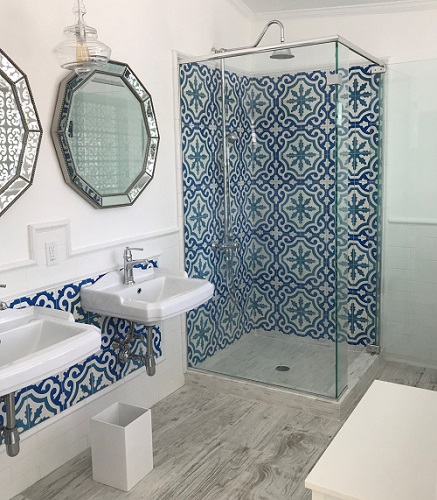
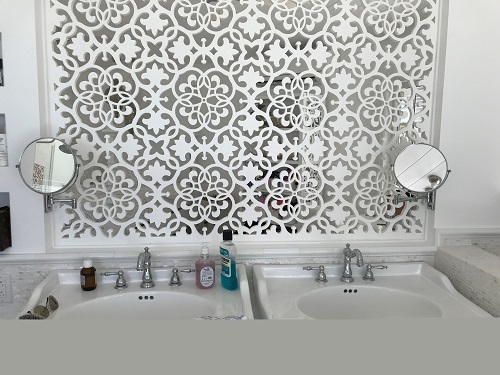
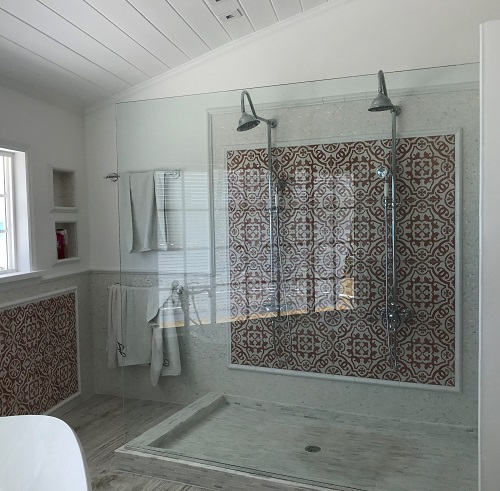
Many homes use natural materials such as granite or hardwood floors to provide a direct connection to nature. Using natural materials throughout the home creates a biophilic benefit. However, you can use man-made materials that also evoke nature for an indirect benefit. Engineered floors can use natural wood patterns, or your quartz countertops might have natural looking color variations in it.
In this home, the grey floors you see in the images above mimics not just the colors of outside stones, but the natural wood grain patterns add a textural indirect benefit.
Interior—Plants, furniture and fixtures
As mentioned, using plants, furniture and fixtures are a valuable way to incorporate biophilic design into your home while being one of the easiest ways to do it in an existing home.
The goal here is to create an over-all feeling for your home that mimics your surrounding natural environment. Putting a money tree in your foyer might be bring you wealth and good fortune, but it will not win you a gold star for biophilic design.
While the furniture and fixtures in this home come from all over the world, all of them are designed to create a more natural environment for the home. The lounges utilize natural materials that evoke nature.


While most of the furniture matches the soft, natural color pallete in the surrounding area, the rugs and pillows are used to create vivid splashes of color to replicate the vibrancy of flowers or colorful birds.
In the photo below, notice the large wooden piece behind the dining room table that not only adds natural material to the home, but also utilizes complex patterns.
Light fixtures are an extremely useful way to build in biophilic features into your home. This home uses Moroccan lights to create playful patterns in the evening. However, this home really goes all in to use lighting to introduce an indirect effect of biophilic design. With the flick of a light switch, you can project blue patterned lights onto the ceiling to replicate the blue waves of the Caribbean Sea outside.

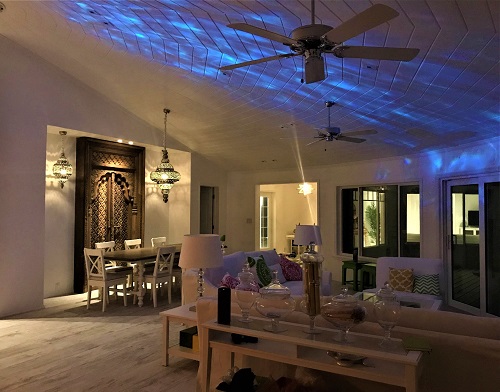
Spatially
All these direct and indirect references to nature create a very special environment that brings out the best benefits of not just island living but also of creating a natural sanctuary that brings the calming benefits of nature in while protecting against her harshest elements. The owners were driven by their desire to create a home that co-existed with nature, but guided by a quote from Axel Munthe:
“My home shall be open for the sun and the wind and the voices of the sea – like a Greek temple – and light, light, light everywhere!”
